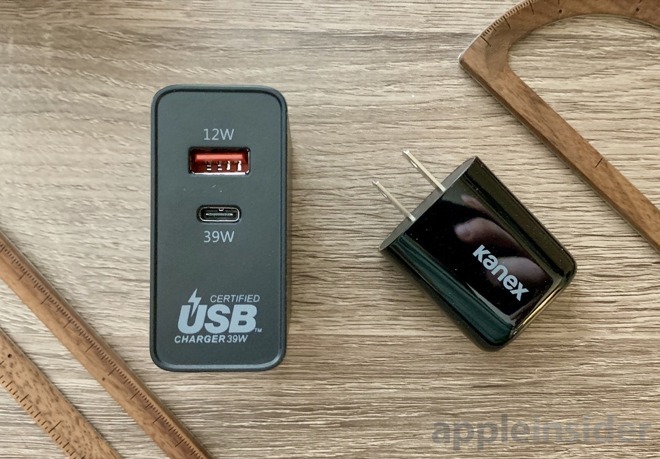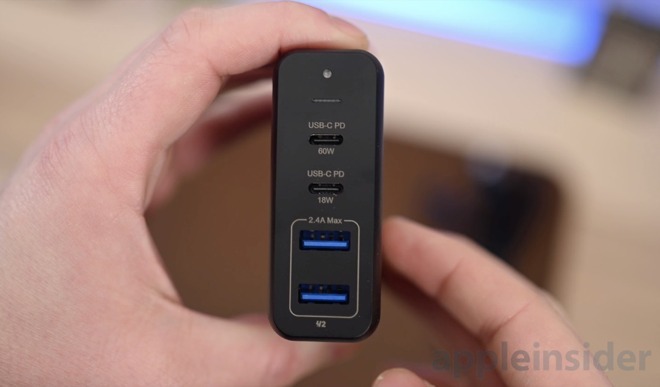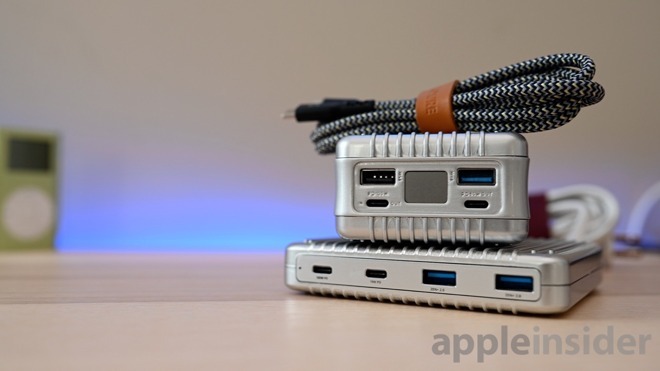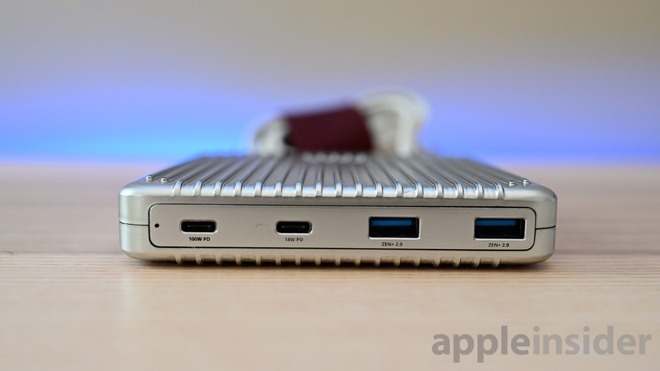Editorial: Manufacturers, it's time to put more USB-C ports on chargers
USB-C has continued to become more ubiquitous as more users adopt the small, reversible port. While all of our accessories are supporting it, chargers are lagging behind. Manufacturers -- it is time to finally create chargers with more than a single USB-C port.
Even if you don't have all your devices switched to USB-C yet, you are surely familiar with the new specification. USB-C is the connector type replacing the aging USB-A port. It is reversible and smaller than type-A ports and it supports faster speeds. USB-C cables that use the USB 3.1 Gen 2 protocol can handle up to 10Gb per second at full duplex.
Apple saw the usefulness of USB-C and made all new portable Macs utilize the cable exclusively, ditching USB-A, DisplayPort, and MagSafe in the process. The new iPad Pro also uses type-C.

Kanex GoPower USB-C chargers
Other accessory makers in the past few years have started to release products using USB-C at a faster rate. Dashcams like Owl use USB-C, as do recent GoPros, the Nikon Z range of cameras, air purifiers like Wynd, and headphones such as the Master & Dynamic ANC over head cans.
The point is, with so much of our gear now relying on the updated port design, why are we limited to chargers that only support one or maybe two USB-C ports max?
It isn't a technical limitation in any way. Chelsea Liu, Zendure Product and Marketing Director told us that "there is no technical difficulty to make full USB-C charger. We just consider to cover future market and existing customers. Not all the electronics accessories have applied USB-C ports. Some of them are still using Micro-USB ports. So it's hard for them to find a USB-C to micro-USB cable to charge devices while USB-A cable has wider compatibility."
When AppleInsider reached out to several accessory makers, the main hangup that we were quoted was that USB-C PD takes too much power for more than two ports to be included on a charger at once. However, that doesn't need to be the case.
USB-C PD -- the PD stands for Power Delivery -- is a dynamic charging technology that can handle up to 100 watts with specific cables and chargers. This is the kind of charger need to power up Apple's latest Macs that use 60W or up to 87W of power draw.

Satechi 75W Dual USB-C multi-charger
What manufacturers seem to be trying to do is keep things simple by making all USB-C ports on their chargers support Power Delivery. Take the Satechi 75W Dual USB-C multi-charger. It sports two USB-C ports, with the top handling 60W output and the second handling 18W. The 60W is great for a Mac while the latter for an iPad Pro.
Then there are two legacy USB-A ports that charge at much lower speeds, usually five or seven watts. These ports are the ones that we wish would be swapped for low-power USB-C ports.
The same can be said for the absolutely exceptional Zendure SuperTank and SuperPort battery and multi-charger we reviewed, though it can handle up to 100W over USB-C.
In our ideal world, we'd have a four-port multi-charger with all USB-C. Two that support USB-C PD at fast speeds for power hungry gear such as Macs or iPads, and two slower ports for headphones, fitness accessories, etc.
Take my standard setup for example. Admittedly, I often truck around with more gear than the average consumer, but I don't think my setup is all that odd.
When I head out, I take my MacBook Pro (or my iPad Pro), my iPhone, my Apple Watch, and a pair of headphones. Both my Mac and iPad Pro use USB-C to charge and with the newfound prevalence of USB-C Lightning cables I also use that to quick charge my iPhone and even my AirPods.
If I'm not taking my AirPods, I take my Master & Dynamic ANC headphones which came with a USB-C cable. I also use a USB-C Apple Watch charger because it can plug into my iPad or Mac.
Other gear that I travel with from time-to-time include my Nikon Z 7, my GoPro Hero 7, or my DJI Osmo, all of which use USB-C. The current option is to grab a bunch of USB-C to USB-A cables which is frustrating to bring along or to just charge two devices at once.
None of this is ideal, as manufacturers like to suggest.
Some have thrown the blame at Apple and the iPhone. "I know Android fans will be shouting at their monitors, but a general mentality in the industry is that until the iPhone commits to a technology, it is just not worth the R&D to really commit to that technology. The iPhone will likely remain lightning this year, but if the iPhone ships with a USB-C --> Lightning cable, game on, multiport USB-C chargers will be everywhere," said Brian Hahn, co-founder and Head of Product at Nomad.
Manufacturers have the ability to create all USB-C chargers without worrying about heat or power by just including slower ports that still put out the same amount of power as current chargers with both type A and C.
Just because the iPhone is still toting around a Lightning port isn't a sufficient excuse either as Apple and nearly all cable manufacturers have started shipping faster USB-C to Lightning cables that would easily benefit from this type of charger.
It is time for them to stop holding on to the legacy ports and embrace USB-C to push the industry forward and to finally allow early adopters and those with newer devices the ability to actually charge their gear the way they should be able to.
Even if you don't have all your devices switched to USB-C yet, you are surely familiar with the new specification. USB-C is the connector type replacing the aging USB-A port. It is reversible and smaller than type-A ports and it supports faster speeds. USB-C cables that use the USB 3.1 Gen 2 protocol can handle up to 10Gb per second at full duplex.
Apple saw the usefulness of USB-C and made all new portable Macs utilize the cable exclusively, ditching USB-A, DisplayPort, and MagSafe in the process. The new iPad Pro also uses type-C.

Kanex GoPower USB-C chargers
Other accessory makers in the past few years have started to release products using USB-C at a faster rate. Dashcams like Owl use USB-C, as do recent GoPros, the Nikon Z range of cameras, air purifiers like Wynd, and headphones such as the Master & Dynamic ANC over head cans.
The point is, with so much of our gear now relying on the updated port design, why are we limited to chargers that only support one or maybe two USB-C ports max?
It isn't a technical limitation in any way. Chelsea Liu, Zendure Product and Marketing Director told us that "there is no technical difficulty to make full USB-C charger. We just consider to cover future market and existing customers. Not all the electronics accessories have applied USB-C ports. Some of them are still using Micro-USB ports. So it's hard for them to find a USB-C to micro-USB cable to charge devices while USB-A cable has wider compatibility."
When AppleInsider reached out to several accessory makers, the main hangup that we were quoted was that USB-C PD takes too much power for more than two ports to be included on a charger at once. However, that doesn't need to be the case.
USB-C PD -- the PD stands for Power Delivery -- is a dynamic charging technology that can handle up to 100 watts with specific cables and chargers. This is the kind of charger need to power up Apple's latest Macs that use 60W or up to 87W of power draw.

Satechi 75W Dual USB-C multi-charger
What manufacturers seem to be trying to do is keep things simple by making all USB-C ports on their chargers support Power Delivery. Take the Satechi 75W Dual USB-C multi-charger. It sports two USB-C ports, with the top handling 60W output and the second handling 18W. The 60W is great for a Mac while the latter for an iPad Pro.
Then there are two legacy USB-A ports that charge at much lower speeds, usually five or seven watts. These ports are the ones that we wish would be swapped for low-power USB-C ports.
The same can be said for the absolutely exceptional Zendure SuperTank and SuperPort battery and multi-charger we reviewed, though it can handle up to 100W over USB-C.
In our ideal world, we'd have a four-port multi-charger with all USB-C. Two that support USB-C PD at fast speeds for power hungry gear such as Macs or iPads, and two slower ports for headphones, fitness accessories, etc.
Take my standard setup for example. Admittedly, I often truck around with more gear than the average consumer, but I don't think my setup is all that odd.
When I head out, I take my MacBook Pro (or my iPad Pro), my iPhone, my Apple Watch, and a pair of headphones. Both my Mac and iPad Pro use USB-C to charge and with the newfound prevalence of USB-C Lightning cables I also use that to quick charge my iPhone and even my AirPods.
If I'm not taking my AirPods, I take my Master & Dynamic ANC headphones which came with a USB-C cable. I also use a USB-C Apple Watch charger because it can plug into my iPad or Mac.
Other gear that I travel with from time-to-time include my Nikon Z 7, my GoPro Hero 7, or my DJI Osmo, all of which use USB-C. The current option is to grab a bunch of USB-C to USB-A cables which is frustrating to bring along or to just charge two devices at once.
None of this is ideal, as manufacturers like to suggest.
Some have thrown the blame at Apple and the iPhone. "I know Android fans will be shouting at their monitors, but a general mentality in the industry is that until the iPhone commits to a technology, it is just not worth the R&D to really commit to that technology. The iPhone will likely remain lightning this year, but if the iPhone ships with a USB-C --> Lightning cable, game on, multiport USB-C chargers will be everywhere," said Brian Hahn, co-founder and Head of Product at Nomad.
Manufacturers have the ability to create all USB-C chargers without worrying about heat or power by just including slower ports that still put out the same amount of power as current chargers with both type A and C.
Just because the iPhone is still toting around a Lightning port isn't a sufficient excuse either as Apple and nearly all cable manufacturers have started shipping faster USB-C to Lightning cables that would easily benefit from this type of charger.
It is time for them to stop holding on to the legacy ports and embrace USB-C to push the industry forward and to finally allow early adopters and those with newer devices the ability to actually charge their gear the way they should be able to.



Comments
hardly any of my devices use USB-A. They are mostly USB-A to micro USB or USB-B.
you are correct that USB-A needs to die. USB-C is the future and those that have USB-A should realize the reality that their USB devices are on borrowed time. USB-C is now showing up in cars. Glad BMW is being proactive in this regard. They are including USB-C chargers in their new models in addition to Qi charging.
USB-A isn't the floppy drive of old. Consider well how long VHS stuck around even when new and superior tech came on the scene. One must also realize that even though Apple has the market share in the mobile space, and therefore can influence most mobile users rapidly, it doesn't have a lock on traditional PCs, and most PCs are still offering USB-A. Indeed, even Apple's own iMacs (thank goodness) include USB-A (and the beloved SD card slot too).
Look, I know the benefits of USB-C. But I also know that to reduce or eliminate dongles we still need USB-A. We need both port types. As such, chargers should come with plenty of USB-A and USB-C ports until such a day that consumers demand otherwise. It should be consumer choice, not something forced upon us by manufacturers, not even Apple. Just because Apple has been successful in the past by forcing things on us doesn't mean such should be true with USB-A. Apple seems to understand this as evidenced by the fact that even the iMac Pro has USB-A. And although the USB-C users among us scream "Consumer choice, YES! I want USB-C only!" the fact is their voices are still small among the enormous sea of USB-A users out there. It's just a fact. USB-A is everywhere. USB-C isn't quite there yet.
USB A is the standard. It may change in the future, but it will take a long time. Apple putting USB C ports on its computers doesn't magically change the rest of the world. As someone mentioned above, though, except for high power devices like MacBooks, it really doesn't matter for charging. You had a USB A to lightning (or Mini USB or micro USB or...) cable. If it doesn't need more than 12W, it really doesn't matter if the other end is USB A or USB C. This is also a reason it will take a long time to change. For the majority of uses, people don't need the power capacity of USB C. It's not unlike coming out with 220V appliances and expecting everyone to start putting 220V plugs in their homes.
USB C is clearly more flexible than USB A - higher power capacity, the ability to handle thunderbolt data in the same port. the problem is, USB C cables are not all the same and can be spec'd differently, so your USB C cable may work for charging but not for thunderbolt or vice versa, essentially adding a whole lot of confusion to the picture.
The USB-C connector is not built to handle higher current flows newer laptops will be needing (you can blame Intel for that).
They also failed to define a clear marking for USB-C cables so power only cables can be id'ed from data only cables or other possible configs.
For now its a USB-A world and will be for quite a few years. Don't forget USB-A is still a cheaper solution which is ideal for slower I/O like mice, trackpads, printers and scanners. Many engineering & medical lab systems still use USB-A and I don't see them changing 80~150k devices out just to get a USB-C connection when it is overkill for what they need.
Is USB-C a good thing? Yes! For data for sure! Power is a bit iffy as long as phones and laptops don't need more power to charge their batteries then it should work (80 watt is about the break point, anything more could cause the cable and connectors to overheat).
Also, stop including a 5W power brick for their latest iPhones. Apple, the absolutely cheapest manufacturer out there and getting worse. $50 premium if you want a keyboard with a number pad. Absolutely ridiculous. Desktop keyboard without a number pad, is really sad, even if you aren't an excel person. Paying a premium may be ok (not really), but $50 premium is too much. Same goes for their SSD upgrade costs (even with the discount as many of the tiers have the same pricing), and the price premium to upgrade from 16GB to 64GB in their iPhones (what, no 32GB option?). Really cheap.
I don't game much at all. The last game I really played was AoE 2, but I want Apple to really have a Mac that supports gaming. I'm tired of integrated graphics and no Nvidia support. Apple, during Macworld, used to demo games and how well they run on their Macs. Not for a long time. Only time this happens is with their iOS demos. Would be nice to place the latest and greatest NVIDIA or AMD GPUs in an upgradable Mac without a hiccup. Yes, this is solely Apple's fault. They could play nicer with other people.
Going back and looking at the specs, the maximum total power for the unit is only 35W— across 5 2.4A and 1 “QC” port— grossly inadequate for six ports. It needs to be at least 60W. That is where most of the effort likely should be spent now IMO.
In the last few months I've installed A/V systems in a PBS studio and at a major tech company's new HQ. Of the many USB connections made, 10% (or less) were USB-C.
It was forward looking of Apple to introduce USB-C when they did. It was short sighted to not include USB-A in most of their offerings.
Fast forward several years, they’re still in use... I don’t think anyone has an iPhone 8 (or newer) so no USB C.
Previously, they’d get new iPhones every year... not any more. The iPhone 7 was good enough, now they’ve been getting cars, computers, AirPods. The iPad mini sees little use, and the iPad Air a bit more, both are still USB A.
Eventually, all the devices will be USB C (as they fail) but it’s a low priority. No need for new wall jacks this year, possibly next year... but 2 will be away at college by then, so why bother...
As for USB C chargers, it will be whatever that comes with the device. USB A was the “golden age” USB C is the necessary evil replacement...
Regardless of your disdain for USB-C the adoption and use grows every year.
Sure, manufacturers should PROVIDE adapters for about two years and then go full throttle.
Its a great standard and does EVERYTHING.
There is no drawback beyond “well... my old compooter on the farm don’t got that newfangled shape!”
thats what adapters are for. Only the luddites use them (as it should be. They have a different gadget for everything). NOT the ones using one port to save them all in order to clean it up and unify things.
I wish Apple went full bore USB C only.
It would make a lot a lot of things so much simpler. We use all Apple where I work. Having to get different types of cables for iMacs and MacBook pros is annoying.
That “limitation” is plenty. But let’s say you really do need greater power overhead in the future. A backward conpatibale USB-C 2 fixes that right up. Just like USB 3, the various FireWire and Thunderbolt revisions, etc.
It’s literally not an issue.